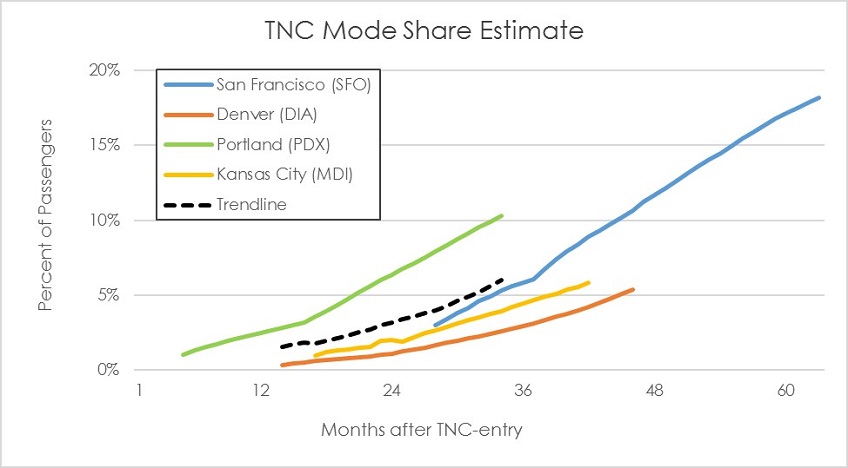Trends in Ground Transportation to and from Airport Reflect Nationwide Mobility Shift
NREL Study Focuses on Growing Use and Impacts of Ride-Hailing Services
Recent studies indicate that both air travel and the use of ride-hailing services such as Uber and Lyft are on the rise in cities around the world. Global demand for air travel is expected to double by 2035, and new airport infrastructure investments and modernization upgrades—costing tens of billions of dollars—are anticipated.
"For the first time in many years, if not decades, passenger transportation and aviation systems are on the frontline of innovation in moving more people faster, cheaper, and better—fueled in part by greater convenience and increased choices, among other things," said Josh Sperling, NREL urban futures and energy nexus engineer. "We can observe and track these transitions through shifts in revenue streams at airports, with implications for the future of ride-hailing, parking, and car rental services in cities, as well as the physical infrastructure supporting each sector."
"The revenue data associated with major transportation hubs, such as airports, signal critical shifts in the adoption of new mobility options, such ride-hailing to and from airports, as opposed to using personal vehicles," Sperling added. "The increasing use of ride-hailing services has major implications for transportation, energy use, revenues, and future infrastructure."
The use of ride-hailing service companies, also referred to as transportation network companies (TNCs), continues to grow—comprising up to 18% of all passenger ground transportation to and from airports.

Percentage of passengers using ride-hailing services when traveling to/from four major U.S. airports
Additionally, the need for airport parking no longer directly reflects growth in the number of airport passengers. Rather, parking revenues per passenger peaked about 12 to 24 months after the introduction of TNCs, and steadily declined thereafter. Initial findings from the four airports considered in the study show an annualized declining rate range of 3% to 7%.
"Continuing this trend would mean that airport parking demand could be cut in half in about 14 years," said Alejandro Henao, a postdoctoral researcher at NREL. "While this can be viewed as a declining revenue base, it could also enable airport growth without additional parking infrastructure investments, freeing up airport property for other uses. It also allows for new revenue streams—airports implementing a TNC fee for ride-hailing pick-ups and drop-offs are seeing an uptick, with Denver and San Francisco earning upwards of $600,000 to $2 million a month in new service-fee revenue."
Looking to the Future
The trends observed from airport data provide an early glance into the rapid adoption of new mobility services. Airport revenue streams shed light on transportation mode shifts in urban areas and provide insight into future demand for parking infrastructure.
Total parking revenue has peaked, and growth in parking demand is not tracking with growth in air travel, with ride-hailing being a major contributor to the shift. As a result, curb demand, rather than parking demand, is a factor in accommodating increased air travel.
For more information on the study, refer to the recent conference paper on the topic—Airport Analyses Informing New Mobility Shifts: Opportunities to Adapt Energy-Efficient Mobility Services and Infrastructure—by NREL's Alejandro Henao, Josh Sperling, Venu Garikapati, Yi Hou, and Stan Young.
Learn more about NREL's sustainable transportation research.
Last Updated May 28, 2025
